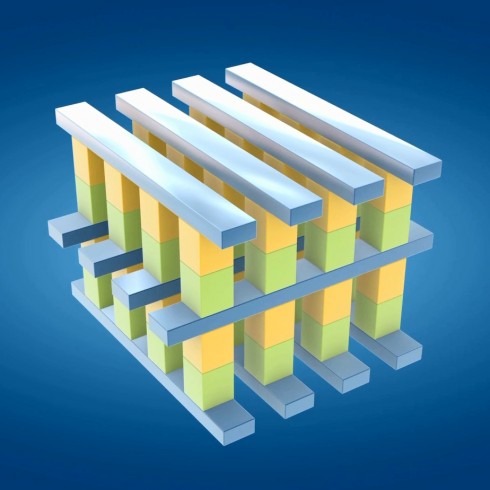(iTers News) - Intel Corp. and Micron Technology, Inc. said that they have begun production on new class of non-volatile memory, creating a new breed of memory technology for the first time in more than 25 years. Trade-marked as 3D XPoint technology, the breakthrough memory technology boasts of speeds of up to 1,000 times faster than conventional NAND, the most popular non-volatile memory available today.
Its new formulation way of material compounds as well as its cross point architecture allow the memory technology to be 10 times denser than conventional memory, which allows the chip maker to cram 100 times more of data storage cells into a given space using the same chip scaling technoogy.
It also boasts of 100 times more endurance than that of conventional NAND flash memory helping the industry tackle the relatively short lifetime challenge of NAND chips. All combined, the faster data write and read speed, higher chip density, and longer endurance will open up yet untapped new breakthrough applications like machine learning, real-time tracking of diseases and immersive 8K gaming.
Now running in wafer fabrication line at Intel and Micron, the 3D XPoint technology is a major breakthrough in memory process technology promising to open up a brave new world of new uncharted application, as its lightning-speed data access will likely unfetter all the limitations facing conventional memory chip technology - the gap or data latency in clock speed between itself and CPUs.
First 128 Gb product due out by year-end
The roll-out marks the first commercial availability of the totally different memory architecture technology since NAND flash was introduced in 1989. The roll out is also to keep up with explosions in data traffics in almost every devcie ranging from data center servers, smart phones, PCs and even cars as the IPv6, ultra high-speed broadband technology, and higher resolution 4K and 8K screen technology combines to spark explosions in the data traffic.
Trure enough, the explosion of connected devices and digital services is generating massive amounts of new data. To make this data useful, it must be stored and analyzed very quickly, creating challenges for service providers and system builders who must balance cost, power and performance trade-offs when they design memory and storage solutions. 3D XPoint technology combines the performance, density, power, non-volatility and cost advantages of all available memory technologies on the market today. The technology is up to 1,000 times faster and has up to 1,000 times greater endurance than NAND, and is 10 times denser than conventional memory.
"For decades, the industry has searched for ways to reduce the lag time between the processor and data to allow much faster analysis," said Rob Crooke, senior vice president and general manager of Intel's Non-Volatile Memory Solutions Group. "This new class of non-volatile memory achieves this goal and brings game-changing performance to memory and storage solutions."
"One of the most significant hurdles in modern computing is the time it takes the processor to reach data on long-term storage," said Mark Adams, president of Micron. "This new class of non-volatile memory is a revolutionary technology that allows for quick access to enormous data sets and enables entirely new applications."
As the digital world quickly grows – from 4.4 zettabytes of digital data created in 2013 to an expected 44 zettabytes by 2020 – 3D XPoint technology can turn this immense amount of data into valuable information in nanoseconds. For example, retailers may use 3D XPoint technology to more quickly identify fraud detection patterns in financial transactions; healthcare researchers could process and analyze larger data sets in real time, accelerating complex tasks such as genetic analysis and disease tracking.
The performance benefits of 3D XPoint technology could also enhance the PC experience, allowing consumers to enjoy faster interactive social media and collaboration as well as more immersive gaming experiences. The non-volatile nature of the technology also makes it a great choice for a variety of low-latency storage applications since data is not erased when the device is powered off.
New recipe, 3D checkboard architecture
Following more than a decade of research and development, 3D XPoint technology was built from the ground up to address the need for non-volatile, high-performance, high-endurance and high-capacity storage and memory at an affordable cost. Its structure is a 3 dimension checkerboard-like that helps significantly reduce latencies, allowing much more data to be stored closer to the processor and accessed at speeds previously impossible for non-volatile storage.
The innovative, transistor-less cross point architecture creates a three-dimensional checkerboard where memory cells sit at the intersection of word lines and bit lines, allowing the cells to be addressed individually. As a result, data can be written and read in small sizes, leading to faster and more efficient read/write processes.
3D XPoint technology will sample later this year with select customers, and Intel and Micron are developing individual products based on the technology.



